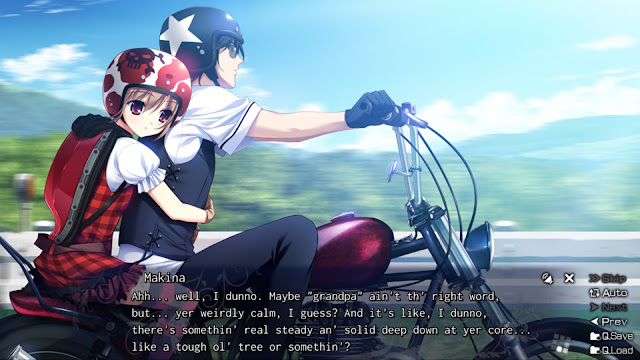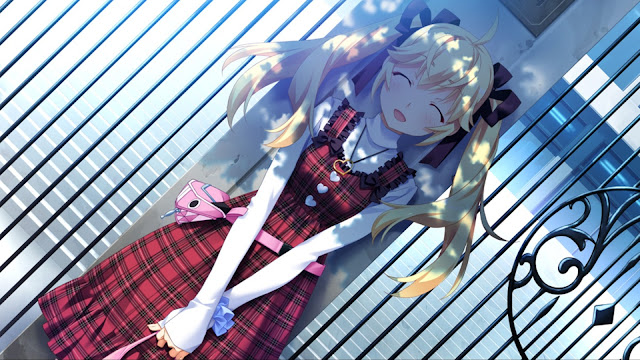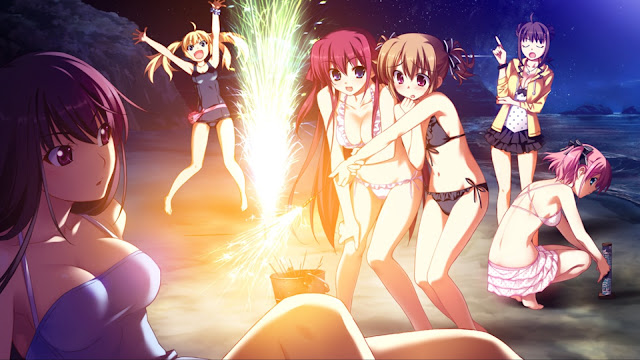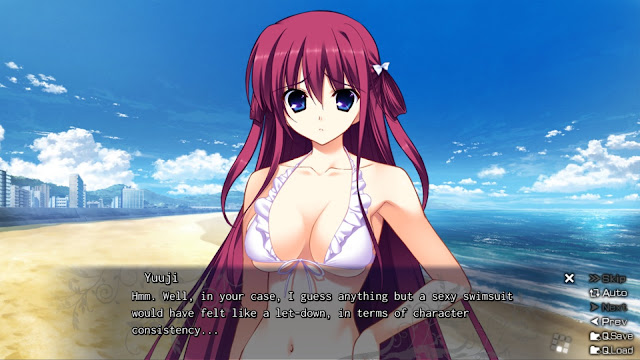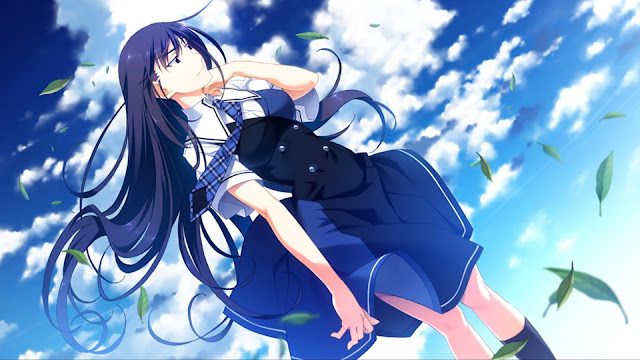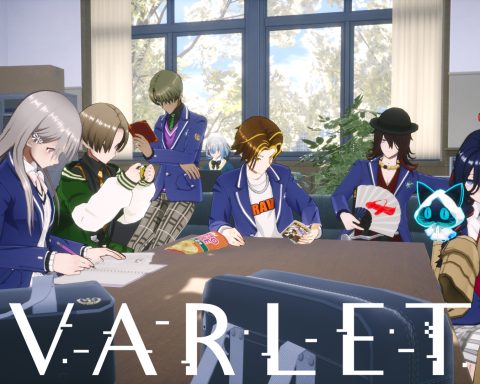The Fruit of Grisaia is an extraordinary work of art. There really is no other way to describe it; to refer to it as a “game” in the traditional sense seems somewhat disingenuous, as even by visual novel standards there’s not a whole lot of player agency here. And yet even as an experience where the sum total of the interactivity in a single playthrough amounts to making just five choices – only two of which matter in four out of the five main narrative routes – The Fruit of Grisaia is, without a doubt, one of the most compelling pieces of interactive fiction ever created.
The Fruit of Grisaia tells the story of protagonist Yuuji, a young man with a somewhat checkered past that has led him to enrol in Mihama Academy, a school for students who, for one reason or another, have fallen out of mainstream education. This school is rather peculiar in that, including Yuuji, there are only six students in attendance. This may sound like a somewhat convoluted and implausible narrative setup, but in practice it’s not actually all that different from the way “special education” is implemented in a number of regions around the world. In practical terms, meanwhile, it keeps the cast to a manageable size and allows the narrative to remain focused.
As an individual work, The Fruit of Grisaia is the first part of a trilogy, but it stands complete and self-contained in its own right. Split into two distinct parts, it’s initially structured more like a collection of short, loosely interconnected stories about Yuuji settling into his new life than a single coherent narrative, but there’s a “point of no return” towards the end of this common route where you lock in the second half to one of five distinct alternatives, each focusing on one of the five main female characters.
And what a cast; The Fruit of Grisaia’s five female heroes are a colourful bunch, running the gamut from the cool, mature, Amazonian stature of Amane to the diminutive childishness of Makina. The interesting thing about the girls is that none of them fit particularly neatly into the most common tropes seen in Japanese visual novels and related media: while each of them may give an initial impression of conforming to a particular archetype, it doesn’t take long to discover that none of them are quite what they seem, even before you get into their individual narrative routes proper.
It’s this contrast between the facade these individuals put up to the world and their real selves that forms the main thrust of each of their discrete narrative paths. In each case, a traumatic event in their past caused them to develop some sort of mental issue, and the five routes each concern themselves with how Yuuji comes to understand the hero in question a little better, and how they learn to come to terms with the various burdens they each bear. It’s not always an easy ride; as Yuuji notes early in the common route, “relationships are difficult things. Too often, we hide ourselves out of consideration for others, and dress up ugly reality with happy lies. Keep it up long enough, and the truth is left irreparably tangled with fiction.”
Yuuji isn’t without his own issues, either, otherwise he wouldn’t have ended up in Mihama Academy himself. Interestingly, Yuuji is reticent to talk too much about himself even when narrating to the reader, instead preferring to allude to things and speak in euphemisms rather than outright hand over information about his situation.
Yuuji is a particularly interesting example of a visual novel protagonist, in fact, since he’s clearly not intended to be a “self-insert” for the player, despite being the only unvoiced character – a visual novel convention usually interpreted as a signal that the reader is supposed to imagine themselves in the role of the protagonist. Rather, he’s his own character in his own right, and by reading The Fruit of Grisaia you’re getting the chance to see events unfold through his eyes, and to develop a peculiarly intimate relationship with him and his innermost thoughts. Indeed, Yuuji almost seems aware of the reader at times, explaining things about his life in his narration and even asking rhetorical questions to consider.
Yuuji’s narration actually provides a solid sense of structure to the individual scenes that make up the complete work, in fact, particularly in the short story-esque common route. He will habitually open a scene with some sort of quasi-philosophical ramblings based on his own past experiences – or, in some cases, wisdom that he picked up via the people with whom he associated prior to the reader meeting him for the first time – which acts as a convenient means of pointing the reader in the direction of how best to interpret the interpersonal reactions they’re about to see between the main cast members. Many interactions and conversations may seem unremarkable at first glance, but placing them in some sort of context with the help of Yuuji’s narration provides an uncannily strong sense that you really are getting to know these people alongside him.
The common route that the game opens with does an excellent job of introducing the characters and giving the reader a good idea of who they are – or, at least, the public face they are inclined to put up to the world. It provides a pleasant, almost comforting sense of finding a “home” with these characters – as Yuuji comments on a class trip, “in that brief moment on the beach, as transitory as the glow of the sparklers in our hands, I forgot to be anxious, frustrated. I forgot that I’m stumbling in fog.” It doesn’t last, of course, but it provides an extremely solid, stable narrative foundation for the rest of the work to build upon.
It’s the five distinct routes where things get particularly interesting, then, since they are all drastically different from one another – not just in terms of the characters they focus on, but also subject matter, themes, tone and resolution. One route, for example, concerns itself with Yakuza-style shady business politics in Japan, revealing a great deal about Yuuji’s mysterious “job” in the process. Another deals with survivor’s guilt following a tragic accident. Another still concerns itself with the lingering effects of a mental breakdown after a bereavement, and the final two explore living with multiple personalities and an unwillingness to live with unreasonable familial and societal “obligations” respectively.
Each of these routes stands complete in its own right, and there’s no real “correct” order to explore them in, but in order to have a full understanding of all the characters, it’s absolutely essential to read all of them – including both their “good” and “bad” endings, since even the “bad” endings, while at times surprisingly horrific and traumatic, often reveal new information in their own right. In particular, it only becomes possible to piece together a complete image of who Yuuji really is from investigating all five of the narrative paths in the game, since the different situations into which the other characters drag him bring different aspects of his past and present to light in various ways. Multi-route visual novels like this have a unique benefit over more linear media in that they can spread their narrative and characterisation content in different directions, and the paths you choose to take and the order in which you choose to take them can potentially provide several very different senses of context to the events you’re watching unfold. It is, however, important to see all of them to get the full experience; to quote Yuuji once again, “dismissing a perspective you can’t understand as ‘ridiculous’ is just an egotistical refusal to admit other ways of looking at the world exist.”
As you might expect from the description above, The Fruit of Grisaia deals with some seriously heavy themes including mental conditions, bereavement, childhood abuse, holding on to your humanity in difficult situations and sexual politics. It handles each of these subjects sensitively and delicately, but without any sense of shame or shying away from the ugly truths of such things.
Even the explicit sexual content found in the 18+ version of the game – which, incidentally, is the version I recommend you play, rather than the somewhat trimmed Steam version – serves a purpose beyond simple titillation: witnessing these uniquely intimate moments between Yuuji and his partner gives us a very personal example of how they have come to regard one another, not to mention the fact that pretty much everyone is willing to confess things in bed that they wouldn’t say out loud anywhere else, and the cast of The Fruit of Grisaia is no exception.
The sex scenes never feel like a “reward”, in other words; they’re there to serve the ongoing story first and foremost, with one in particular seemingly designed to provoke some very conflicted emotions on the part of the player by masterfully blending heartbreaking pathos, highly charged eroticism and even a dash of humour, all in the space of about five minutes.
The sex is, to a certain degree, symbolic, too; as is traditionally the case in most eroge, all of the heroines are virgins at the outset of the story, and the handing over of their maidenhood to Yuuji is intended to reflect absolute trust on their part as well as the willingness to let him in to the darker, more secret parts of their life. For some characters, this happens sooner (and more frequently) than others; one route in particular is very much front-loaded with sexual content, though its remainder provides all the narrative clues you need to interpret exactly why the character in question has decided to live her life that way.
One particularly praiseworthy aspect of all five routes is that Yuuji never once acts as a “magic bullet” to solve the girl’s problems for her. On numerous occasions, he expresses a desire to “save” her from the lingering effects of the trauma in her past, but he’s an intelligent sort of person, and knows that simply handing over an easy life on a plate to someone is no way to help them grow and become stronger. He has plenty of his own woes to deal with, anyway; not all of these are fully explored over the course of The Fruit of Grisaia, with some of the more intriguing mysteries clearly intended to be resolved more fully in the subsequent two installments, but by the time you’ve seen everything here, you’ve got more than enough to go on in terms of understanding Yuuji and precisely what makes him tick.
As for the girls, all of the routes here provide a good sense of closure within the individual work, though this doesn’t necessarily mean that their problems have been completely resolved or that there’s nothing more to explore in the subsequent installments. Rather, in most cases we see a situation that more concerns how they’ve learned to cope with their own personal circumstances than “cure” whatever ailed them. As Yuuji notes, “in childhood, everyone’s convinced that snow-white wings are budding on their back. We tell ourselves, ‘someday, I’ll fly away from here to some strange and wonderful place.’ We think that by going where we want to go, we’ll magically become the person we want to be. But in reality, there’s nowhere else to go, and no feathers to lift us out of the dust. When we finally realise this, it’s hard to overstate how bitter a disappointment it is.”
The reflection of this realisation in each of the routes – life isn’t simple, and problems don’t tend to wrap themselves up neatly – provides a sense of the overall story being somewhat grounded in reality; trauma isn’t something you just “get over” with the help of an understanding partner, after all, and sometimes you never completely get over it: you just learn to handle it.
Yuuji and the heroines aren’t the only stars, though; each of the other routes introduce some secondary characters, and while we tend to spend less time with these than the main cast – some of them are confined purely to flashback scenes – they are just as well-realised, and in fact in several cases they provide some interesting non-verbal cues that make good use of the “visual” part of the visual novel medium. In one route, for example, a character in a flashback is seen wearing a scrunchie-style bracelet on her left wrist, which observant readers will notice bears a striking resemblance to a similar bracelet on the wrist of that path’s hero. In one of the other routes, an acquaintance from years gone by is seen using some distinctive body language in the character’s memories – playing with her hair, her hand held in a slightly awkward position – and, again, observant readers will note that she has unconsciously picked up this mannerism in her own right. Neither of these things are addressed directly in the text – and doubtless there are more that I’ve missed, too – but they provide some seriously compelling evidence that the writers of The Fruit of Grisaia very much think of these characters as complete people, even if many aspects of their personalities aren’t explicitly reflected through narration and dialogue.
The Fruit of Grisaia as a whole makes good use of the visual novel medium, in fact, striking a good balance between using narration, dialogue, voice acting, music, sound, character art and background scenery to inspire imagery in the reader’s mind. Specific “event” images are relatively rare, which means that they have significant impact when they do come up; in many other cases, we’re forced to rely on the narration of Yuuji – or, in some cases, the girls – to get a sense of what’s going on, and on more than one occasion we see the aftermath of an event rather than the event itself, allowing us to “fill in the blanks” ourselves as we see fit. This helps to preserve an element of mystery to the whole experience, and helps the reader to feel involved even with the extreme lack of agency The Fruit of Grisaia as a whole provides.
That feeling of involvement comes from another source, too: the characters themselves. Your mileage may vary depending on your own life experiences, but I found each and every one of them to be relatable in one way or another. They’re all (including Yuuji) flawed, sympathetic and, above all, realistic characters that it’s easy to empathise with, but at no point does it feel like the writers are milking the characters for overexaggerated melodrama. On the contrary, the pacing and structure is such that for every highly charged emotional scene, there’s something a bit more light-hearted to follow; in this way, we get to see the characters in a wide variety of contexts and come to think of them as well-rounded people rather than “the miserable one”, “the angry one”, “the sexually aggressive one” and so forth. It also helps the reader to recuperate from whatever the latest emotional gutpunch the story delivered might have been; without these moments of relative calm, the truly affecting moments would lose some of their impact, and The Fruit of Grisaia’s writers demonstrate a very clear understanding, and mastery of, this particular technique.
In fact, I don’t think it would be an exaggeration to say that, despite the clear lack of player input aside from the aforementioned five choices, Grisaia is one of the most involving, emotionally engaging visual novels ever created. It draws the reader in with its convincing depiction of a peaceful (if somewhat unconventional) school life, then takes full advantage of this solid foundation of engagement by taking you on one of five strange, wonderful, unpredictable, dramatic, romantic, thrilling, erotic, terrifying journeys, all of which will leave you with the sense that you’re looking at the world just a little bit differently afterwards.
The Fruit of Grisaia is a masterpiece, in short, and anyone with the slightest interest in interactive fiction owes it to themselves to immerse themselves in these utterly remarkable stories.
– Pete D.
Contributor


